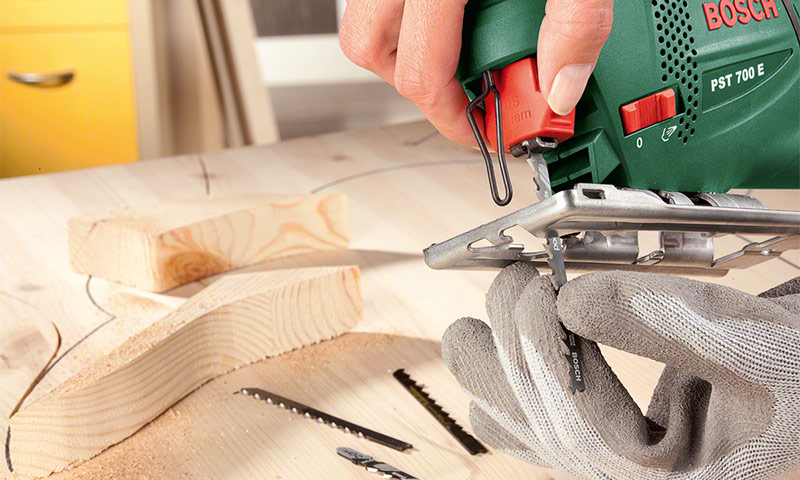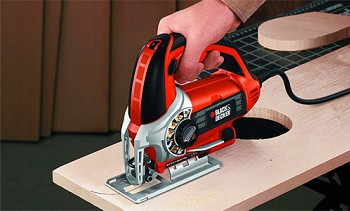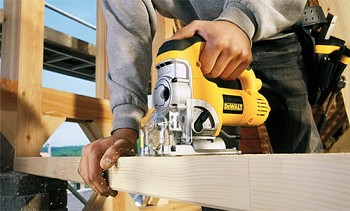The jigsaw is essentially a universal tool that allows you to perform straight and curly cuts of a wide variety of materials - from soft wood to steel and glass. However, the tool itself is universal, but not its equipment: for each task a certain type of saw blade is required. To understand how to choose a file for a jigsaw in each case, you need to figure out what criteria to use when choosing, how some canvases differ from others, and how to guess about it by their marking.
Arriving at the store and looking at the counter with jigsaw files, you will find that they are all very different. They differ not only in the length, width and thickness of the blade, but also in the size of the teeth, the geometry of the cutting edge and the shape of the tail. In this material we will consider what types of jigsaw blades are available, their features and selection parameters.

Content:
Types of Shanks for Jigsaws
The first thing you should pay attention to when choosing a file for a jigsaw is the type of its shank. And this is logical: if your tool is not designed to work with such a variety, then you simply can not use the new canvas. There are actually not so many options:
T-Shank.
Often it is called "Boshevsky", because it was this company that developed the files with this type of shank. Since BOSCH is a leader in the market of jigsaws and accessories for them, and other industry giants are trying to move to this standard, it is not surprising that T-shank files are currently the most common. T-shank fits most modern jigsaws - Bosch, Makita, Metabo, Hitachi, Skil, AEG, DeWalt, Sparky, Interskol, etc.

U Shank.
The second most popular version of the shank, the American standard. This is a universal shank for older models of Skil, DeWalt, Wolf, Ryobi, Stayer, Black & Decker and others. Such files are suitable for all jigsaws with shoe and screw clamps.

Makita Shank.
Files with this shank are only compatible with older Makita jigsaws.

Bosch Shank.
It differs from the T-shaped shank only in the presence of a second stop. These files are exclusively suitable for older Bosch models.

The last two types of shanks can already be classified as rare. To find such files in domestic stores today is almost impossible.
Sizes of files
Blade length. The length of the saw blade can vary in a fairly wide range - from 40 to 250 mm. The longer the file, the thicker the workpiece it can cut. It should be borne in mind that the really achievable cut depth depends not only on the length of the blade, but also on the capabilities of the tool itself. It is better to use short files for sawing thin materials: their use guarantees a neat clean cut, because the process is not prevented by the deformation of an excessively long web.

Web width. The width of the blade is selected depending on the type of operations that are supposed to be performed using a jigsaw. Wide straight files are ideal for straight cuts: they are easier to lead in a given direction, which means that the cut line is smooth.

For curly cuts, on the contrary, you need a canvas with a narrow back, which is easier to perform various maneuvers, "drawing" smooth curves.

Web thickness. And finally, the thicker the file, the less it will deviate from a vertical position during operation, i.e. cut along its entire length will be perpendicular to the surface of the material.However, in pursuit of a neat cut, do not forget that too thick files may not fit jigsaws with a quick-clamp mechanism.
Varieties of files on the geometry of the cutting edge
If you look closely at the jigsaw files, you can see that they all differ in the size of the wiring of the teeth and the geometry of the sawing edge. The stronger the teeth are bred, the wider the cutting line will be, thereby increasing the speed of work, however, at the cost of reducing the quality of saw cut. Not only the cleanliness of the cuts depends on the wiring method, but also what materials you can use this equipment to work with.
Milled with classic wiring.

Features. For saws with a classic wiring, the teeth are alternately bent in different directions, like conventional hand saws. This wiring helps to reduce the heating of the saw during operation, since the blade almost does not experience friction in a fairly wide cut. To get a neat cut with such a file is almost impossible, but the speed will be high.
Appointment. The purpose of saw blades with milled teeth and classic wiring is a quick cut of hard and soft wood, as well as plastic and non-ferrous metals.
Milled with wavy wiring.

Features. In equipment with such a wiring, the teeth change direction not alternately, as in the previous case, but in groups of several pieces. Moreover, for each tooth, the deviation from the central axis is not the same as for its closest neighbors - the working edge of the saw blade forms a wave.
Appointment. The purpose of the files with wavy wiring is a clean cut not only for wood, but also for chipboard or plywood, as well as working with non-ferrous metals and plastic.
Sanded with classic wiring.

Features. The teeth of such canvases are set apart and undergo the grinding process. The cutting line of such paintings is quite wide.
Appointment. Saws with polished teeth, bred in the classical way, are designed for quick, but relatively clean cutting of wood and its derivatives - chipboard, fiberboard, etc.
With conical grinding without wiring.

Features. The canvases of such files do not have a tooth divorce, but their segments are polished, which ensures a thin cut line and a smooth cut.
Appointment. They allow for accurate cutting of wood, laminate, polymeric materials.
Classification of jigsaw blades by type of material to be processed
For wood and wood materials
Initially, a jigsaw was created to work exclusively with wood. Modern tools have learned to saw both metal and plastic, however, their main purpose is still cutting wood and its derivatives. That is why most of the assortment of saw blades is designed to work with these materials. “Wooden” files are divided into groups according to the type of work for which they are intended.
Quick cut.
When carrying out some types of woodwork, it is often not accuracy that is important, but the speed of the process. The saw files for fast cutting of wood are capable of providing high productivity. They are easy to recognize by the following characteristic signs:
- long canvas (from 60 mm),
- large teeth (up to 6 mm),
- large amount of divorce (about 1 mm).

Tip: For sawing wood across the fibers, straight tooth blades are also suitable; for a longitudinal cut, files with a slanting tooth are more suitable.
Clean cut.
Operations such as cutting furniture panels from chipboard or cutting parquet boards require a smooth and accurate cut. When solving such problems, where work quality comes to the fore rather than productivity, we use blades for a clean cut, having:
- average tooth size (no more than 3 mm),
- minor divorce.
In most nail files, the teeth are directed toward the jigsaw. To ensure that the front side of the material after cutting a chipboard or laminate is as neat as possible, without chips and scoring, the workpiece is placed with the back to itself / the tool. To cut from the "face", you need to use a blade with a back tooth.True, it’s more difficult to work than usual - you have to overcome the force of pushing the tool.

Tip: Carefully, without chips, a special file with two rows of teeth allows you to cut the panels laminated on both sides.
Figure cut.
It is almost impossible to cut a curve with a small radius with an ordinary wide blade. For a curly cut, specialized files are used, which, due to their size, easily pass rounded sections:
- narrow canvas (no more than 4 mm),
- small teeth (up to 2 mm),
- short length (up to 40 mm),
- beveled back.

For metal
I must admit that the jigsaw is not suitable for metal cutting: the tool can hardly cope with the load, the process is very slow, the files are quickly dull. However, sometimes this extreme way is justified.
Saws for metal differ from saws for wood: they are made of especially strong steel and have small (up to 1 mm) teeth, bred in a wavy way. If you often use a jigsaw and at the same time carry out a variety of work with it, we recommend that you keep at once three metal sheets at once - separately for aluminum, other non-ferrous metals and steel. If you have to cut metal only occasionally, it will be enough to have only a file for steel - it will certainly cope with the cutting of products from colormet.

For polymeric materials
For cutting pipes and other PVC products, large tooth blades suitable for cutting wood or metal are suitable.
Fine-tooth files will also cope with the task, but they will have to cut at a minimum speed, otherwise the plastic sawdust softened by high temperature will clog the teeth of the file. For thin sheets of plastic and plexiglass, metal sheets with fine teeth are excellent. To cut thick plastic, you can take a file on wood and cut at low speeds.

For specific tasks
Saws designed for glass and ceramics are made of especially strong alloys and have diamond spraying on their cutting edges or more often tungsten carbide spraying. Use a jigsaw to cut ceramic tiles or glass makes sense only if you need to cut curly elements; For direct cutting of these materials, there are other, more suitable tools.

Drywall and other building materials containing abrasive particles of gypsum, cement or sand quickly blunt any files. An exception is saw blades specially designed for these materials with carbide brazing on the cutting edge.

A file designed for cutting cardboard, rubber and other soft materials is more like a knife. She is “toothless”, and her cutting edge is made in the form of polished waves.

Universal
Universal files, made, as a rule, of high-speed steel, are used to work with various materials - wood, plastic, metal. Expect a high quality cut when using them is not worth it.

How to decipher the marking of the file
Determining the purpose of a file solely by its appearance is by no means an easy task; this requires experience. For those who have not enough such experience, we recommend focusing primarily on the markings on the canvas, which contains all the necessary information. There is no single standard for marking files, but most manufacturers try to adhere to the Bosch classification.

#1. On the tail of each file there is a set of numbers and letters.
The first letter indicates the type of shank, for example, T-shaped or U-shaped. It is followed by a figure, the value of which can be used to judge the length of the canvas:
- 1 - short (up to 75 mm),
- 2 - standard (75-90 mm),
- 3 - elongated (90-150 mm),
- 7 - long (more than 150 mm).
In the second and third digits, the purpose of the file is encrypted. We will not deal with their decoding, since this information is duplicated on file in other forms that are more accessible for understanding and memorization.
After the numbers, the letter is again - it indicates the size of the teeth:
- A - small (for cutting the laminate),
- B - medium (for sawing wood, plywood, fiberboard, chipboard, etc.),
- C and D are large (for rough cut).
And finally, the last letter will help to get additional information about the file:
- F - bimetallic fabric (considered the most durable and durable),
- O - narrow canvas (for figured cut),
- P - thick blade (allows you to cut strictly perpendicular to the surface),
- R - with a back tooth
- X - with a variable tooth size (universal blade suitable for cutting any materials).
#2. The purpose of the file can be determined by the color of the shank:
- gray - for wood,
- blue - for metal,
- white - for wood and metal,
- red - for plastic,
- black - other materials.
#3. The purpose of the saw blade is determined primarily by the grade of steel from which it is made. The letter of the steel grade can be found on the neck of the file, i.e. at the border of the shank and the blade itself:
- CV - chrome vanadium steel (for wood and wood-based panels),
- HCS - high carbon steel (for wood and wood-based panels, as well as plastic),
- HSS - high-speed steel (for ferrous and non-ferrous metals),
- HM - tungsten carbide-based carbide (for ceramics, fiberglass, etc.)
BM (or BIM, or Bi-Metal) is a highly elastic combination of HSS and HCS (professional files for wood and metal).
#4. Marks on the blade also indicate the purpose of the file:
- Wood - for soft wood and fiber boards,
- Hardwood - for solid wood and laminated panels,
- Inox - for stainless steel,
- Alu - for aluminum,
- Metal - for tin, metal profiles and pipes,
- Fiber & Plaster - for fiberglass,
- Soft-material - for soft materials (rubber, foam, cardboard, etc.),
- Acrylic - for polycarbonate and plexiglass.
#5. Sometimes on the canvas there is still an inscription clarifying the type of work:
- basic - standard blades for high-quality cutting,
- speed - files for quick cutting,
- clean - blades for a clean cut (without wiring teeth),
- progressor - universal files with variable tooth size,
- flexible - wavy blades for metal cutting,
- special - files for cutting ceramics, plastic and other highly specialized works.



